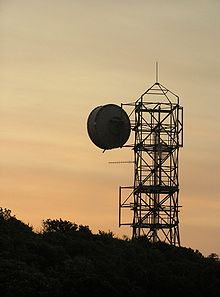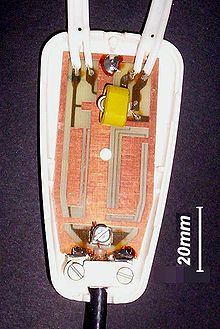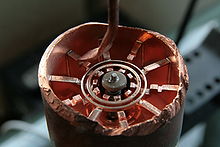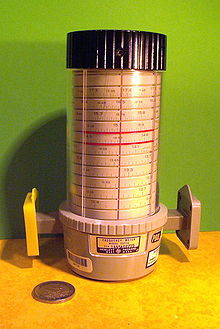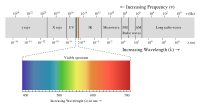- Microwave
-
This article is about the electromagnetic wave. For the cooking appliance, see Microwave oven. For other uses, see Microwaves (disambiguation).
Microwaves, a subset of radio waves, have wavelengths ranging from as long as one meter to as short as one millimeter, or equivalently, with frequencies between 300 MHz (0.3 GHz) and 300 GHz.[1] This broad definition includes both UHF and EHF (millimeter waves), and various sources use different boundaries.[2] In all cases, microwave includes the entire SHF band (3 to 30 GHz, or 10 to 1 cm) at minimum, with RF engineering often putting the lower boundary at 1 GHz (30 cm), and the upper around 100 GHz (3 mm).
Apparatus and techniques may be described qualitatively as "microwave" when the wavelengths of signals are roughly the same as the dimensions of the equipment, so that lumped-element circuit theory is inaccurate. As a consequence, practical microwave technique tends to move away from the discrete resistors, capacitors, and inductors used with lower-frequency radio waves. Instead, distributed circuit elements and transmission-line theory are more useful methods for design and analysis. Open-wire and coaxial transmission lines give way to waveguides and stripline, and lumped-element tuned circuits are replaced by cavity resonators or resonant lines. Effects of reflection, polarization, scattering, diffraction, and atmospheric absorption usually associated with visible light are of practical significance in the study of microwave propagation. The same equations of electromagnetic theory apply at all frequencies.
The prefix "micro-" in "microwave" is not meant to suggest a wavelength in the micrometer range. It indicates that microwaves are "small" compared to waves used in typical radio broadcasting, in that they have shorter wavelengths. The boundaries between far infrared light, terahertz radiation, microwaves, and ultra-high-frequency radio waves are fairly arbitrary and are used variously between different fields of study.
Electromagnetic waves longer (lower frequency) than microwaves are called "radio waves". Electromagnetic radiation with shorter wavelengths may be called "millimeter waves", terahertz radiation or even T-rays. Definitions differ for millimeter wave band, which the IEEE defines as 110 GHz to 300 GHz.
Above 300 GHz, the absorption of electromagnetic radiation by Earth's atmosphere is so great that it is in effect opaque, until the atmosphere becomes transparent again in the so-called infrared and optical window frequency ranges.
Contents
Microwave sources
Vacuum tube devices operate on the ballistic motion of electrons in a vacuum under the influence of controlling electric or magnetic fields, and include the magnetron, klystron, traveling-wave tube (TWT), and gyrotron. These devices work in the density modulated mode, rather than the current modulated mode. This means that they work on the basis of clumps of electrons flying ballistically through them, rather than using a continuous stream.
Low-power microwave sources use solid-state devices such as the field-effect transistor (at least at lower frequencies), tunnel diodes, Gunn diodes, and IMPATT diodes.[3]
A maser is a device similar to a laser, which amplifies light energy by stimulating photons. The maser, rather than amplifying light energy, amplifies the lower frequency, longer wavelength microwaves and radio frequency emissions.
The sun also emits microwave radiation, and most of it is blocked by Earth's atmosphere.[4][not in citation given]
The Cosmic Microwave Background Radiation (CMBR) is a source of microwaves that supports the science of cosmology's Big Bang theory of the origin of the Universe.
Uses
Communication
Before the advent of fiber-optic transmission, most long-distance telephone calls were carried via networks of microwave radio relay links run by carriers such as AT&T Long Lines. Starting in the early 1950s, frequency division multiplex was used to send up to 5,400 telephone channels on each microwave radio channel, with as many as ten radio channels combined into one antenna for the hop to the next site, up to 70 km away.
Wireless LAN protocols, such as Bluetooth and the IEEE 802.11 specifications, also use microwaves in the 2.4 GHz ISM band, although 802.11a uses ISM band and U-NII frequencies in the 5 GHz range. Licensed long-range (up to about 25 km) Wireless Internet Access services have been used for almost a decade in many countries in the 3.5–4.0 GHz range. The FCC recently[when?] carved out spectrum for carriers that wish to offer services in this range in the U.S. — with emphasis on 3.65 GHz. Dozens of service providers across the country are securing or have already received licenses from the FCC to operate in this band. The WIMAX service offerings that can be carried on the 3.65 GHz band will give business customers another option for connectivity.
Metropolitan area network (MAN) protocols, such as WiMAX (Worldwide Interoperability for Microwave Access) are based on standards such as IEEE 802.16, designed to operate between 2 to 11 GHz. Commercial implementations are in the 2.3 GHz, 2.5 GHz, 3.5 GHz and 5.8 GHz ranges.
Mobile Broadband Wireless Access (MBWA) protocols based on standards specifications such as IEEE 802.20 or ATIS/ANSI HC-SDMA (such as iBurst) operate between 1.6 and 2.3 GHz to give mobility and in-building penetration characteristics similar to mobile phones but with vastly greater spectral efficiency.[5]
Some mobile phone networks, like GSM, use the low-microwave/high-UHF frequencies around 1.8 and 1.9 GHz in the Americas and elsewhere, respectively. DVB-SH and S-DMB use 1.452 to 1.492 GHz, while proprietary/incompatible satellite radio in the U.S. uses around 2.3 GHz for DARS.
Microwave radio is used in broadcasting and telecommunication transmissions because, due to their short wavelength, highly directional antennas are smaller and therefore more practical than they would be at longer wavelengths (lower frequencies). There is also more bandwidth in the microwave spectrum than in the rest of the radio spectrum; the usable bandwidth below 300 MHz is less than 300 MHz while many GHz can be used above 300 MHz. Typically, microwaves are used in television news to transmit a signal from a remote location to a television station from a specially equipped van. See broadcast auxiliary service (BAS), remote pickup unit (RPU), and studio/transmitter link (STL).
Most satellite communications systems operate in the C, X, Ka, or Ku bands of the microwave spectrum. These frequencies allow large bandwidth while avoiding the crowded UHF frequencies and staying below the atmospheric absorption of EHF frequencies. Satellite TV either operates in the C band for the traditional large dish fixed satellite service or Ku band for direct-broadcast satellite. Military communications run primarily over X or Ku-band links, with Ka band being used for Milstar.
Radar
Radar uses microwave radiation to detect the range, speed, and other characteristics of remote objects. Development of radar was accelerated during World War II due to its great military utility. Now radar is widely used for applications such as air traffic control, weather forecasting, navigation of ships, and speed limit enforcement.
A Gunn diode oscillator and waveguide are used as a motion detector for automatic door openers.
Radio astronomy
Most radio astronomy uses microwaves. Usually the naturally-occurring microwave radiation is observed, but active radar experiments have also been done with objects in the solar system, such as determining the distance to the Moon or mapping the invisible surface of Venus through cloud cover.
Global Navigation Satellite Systems (GNSS) including the Chinese Beidou, the American Global Positioning System (GPS) and the Russian GLONASS broadcast navigational signals in various bands between about 1.2 GHz and 1.6 GHz.
Power
A microwave oven passes (non-ionizing) microwave radiation (at a frequency near 2.45 GHz) through food, causing dielectric heating by absorption of energy in the water, fats, and sugar contained in the food. Microwave ovens became common kitchen appliances in Western countries in the late 1970s, following development of inexpensive cavity magnetrons. Water in the liquid state possesses many molecular interactions that broaden the absorption peak. In the vapor phase, isolated water molecules absorb at around 22 GHz, almost ten times the frequency of the microwave oven.
Microwave heating is used in industrial processes for drying and curing products.
Many semiconductor processing techniques use microwaves to generate plasma for such purposes as reactive ion etching and plasma-enhanced chemical vapor deposition (PECVD).
Microwave frequencies typically ranging from 110 – 140 GHz are used in stellarators and more notably in tokamak experimental fusion reactors to help heat the fuel into a plasma state. The upcoming ITER Thermonuclear Reactor[6] is expected to range from 110–170 GHz and will employ Electron Cyclotron Resonance Heating (ECRH).[7]
Microwaves can be used to transmit power over long distances, and post-World War II research was done to examine possibilities. NASA worked in the 1970s and early 1980s to research the possibilities of using solar power satellite (SPS) systems with large solar arrays that would beam power down to the Earth's surface via microwaves.
Less-than-lethal weaponry exists that uses millimeter waves to heat a thin layer of human skin to an intolerable temperature so as to make the targeted person move away. A two-second burst of the 95 GHz focused beam heats the skin to a temperature of 130 °F (54 °C) at a depth of 1/64th of an inch (0.4 mm). The United States Air Force and Marines are currently using this type of active denial system.[8]
Spectroscopy
Microwave radiation is used in electron paramagnetic resonance (EPR or ESR) spectroscopy, typically in the X-band region (~9 GHz) in conjunction typically with magnetic fields of 0.3 T. This technique provides information on unpaired electrons in chemical systems, such as free radicals or transition metal ions such as Cu(II). The microwave radiation can also be combined with electrochemistry as in microwave enhanced electrochemistry.
Microwave frequency bands
The microwave spectrum is usually defined as electromagnetic energy ranging from approximately 1 GHz to 100 GHz in frequency, but older usage includes lower frequencies. Most common applications are within the 1 to 40 GHz range. Microwave frequency bands, as defined by the Radio Society of Great Britain (RSGB), are shown in the table below:
ITU Radio Band Numbers ITU Radio Band Symbols NATO Radio bands IEEE Radar bands Microwave frequency bands Letter Designation Frequency range L band 1 to 2 GHz S band 2 to 4 GHz C band 4 to 8 GHz X band 8 to 12 GHz Ku band 12 to 18 GHz K band 18 to 26.5 GHz Ka band 26.5 to 40 GHz Q band 33 to 50 GHz U band 40 to 60 GHz V band 50 to 75 GHz E band 60 to 90 GHz W band 75 to 110 GHz F band 90 to 140 GHz D band 110 to 170 GHz Footnote (1): P band is sometimes incorrectly used for Ku Band. "P" for "previous" was a radar band used in the UK ranging from 250 to 500 MHz and now obsolete per IEEE Std 521, see [9] and.[10] For other definitions see Letter Designations of Microwave Bands.
Footnote (2): When radars were first developed at K band during World War II, it was not realized that there was a nearby absorption band (due to water vapor and oxygen at the atmosphere). To avoid this problem, the original K band was split into a lower band, Ku, and upper band, Ka see.[11]
Microwave frequency measurement
Microwave frequency can be measured by either electronic or mechanical techniques.
Frequency counters or high frequency heterodyne systems can be used. Here the unknown frequency is compared with harmonics of a known lower frequency by use of a low frequency generator, a harmonic generator and a mixer. Accuracy of the measurement is limited by the accuracy and stability of the reference source.
Mechanical methods require a tunable resonator such as an absorption wavemeter, which has a known relation between a physical dimension and frequency.
In a laboratory setting, Lecher lines can be used to directly measure the wavelength on a transmission line made of parallel wires, the frequency can then be calculated. A similar technique is to use a slotted waveguide or slotted coaxial line to directly measure the wavelength. These devices consist of a probe introduced into the line through a longitudinal slot, so that the probe is free to travel up and down the line. Slotted lines are primarily intended for measurement of the voltage standing wave ratio on the line. However, provided a standing wave is present, they may also be used to measure the distance between the nodes, which is equal to half the wavelength. Precision of this method is limited by the determination of the nodal locations.
Health effects
Microwaves do not contain sufficient energy to chemically change substances by ionization, and so are an example of nonionizing radiation. The word "radiation" refers to the fact that energy can radiate. The term in this context is not to be confused with radioactivity. It has not been shown conclusively that microwaves (or other nonionizing electromagnetic radiation) have significant adverse biological effects at low levels. Some, but not all, studies suggest that long-term exposure may have a carcinogenic effect.[12] This is separate from the risks associated with very high intensity exposure, which can cause heating and burns like any heat source, and not a unique property of microwaves specifically.
During World War II, it was observed that individuals in the radiation path of radar installations experienced clicks and buzzing sounds in response to microwave radiation. This microwave auditory effect was thought to be caused by the microwaves inducing an electric current in the hearing centers of the brain.[13] Research by NASA in the 1970s has shown this to be caused by thermal expansion in parts of the inner ear.
When injury from exposure to microwaves occurs, it usually results from dielectric heating induced in the body. Exposure to microwave radiation can produce cataracts by this mechanism, because the microwave heating denatures proteins in the crystalline lens of the eye (in the same way that heat turns egg whites white and opaque) faster than the lens can be cooled by surrounding structures. The lens and cornea of the eye are especially vulnerable because they contain no blood vessels that can carry away heat. Exposure to heavy doses of microwave radiation (as from an oven that has been tampered with to allow operation even with the door open) can produce heat damage in other tissues as well, up to and including serious burns that may not be immediately evident because of the tendency for microwaves to heat deeper tissues with higher moisture content.
History and research
The existence of electromagnetic waves was predicted by James Clerk Maxwell in 1864 from his equations. In 1888, Heinrich Hertz was the first to demonstrate the existence of electromagnetic waves by building an apparatus that produced and detected microwaves in the UHF region. The design necessarily used horse-and-buggy materials, including a horse trough, a wrought iron point spark, Leyden jars, and a length of zinc gutter whose parabolic cross-section worked as a reflection antenna. In 1894 J. C. Bose publicly demonstrated radio control of a bell using millimeter wavelengths, and conducted research into the propagation of microwaves.[14]
Perhaps the first, documented, formal use of the term microwave occurred in 1931:
- "When trials with wavelengths as low as 18 cm were made known, there was undisguised surprise that the problem of the micro-wave had been solved so soon." Telegraph & Telephone Journal XVII. 179/1
In 1943, the Hungarian engineer Zoltán Bay sent ultra-short radio waves to the moon, which, reflected from there, worked as a radar, and could be used to measure distance, as well as to study the moon.[15]
Perhaps the first use of the word microwave in an astronomical context occurred in 1946 in an article "Microwave Radiation from the Sun and Moon" by Robert Dicke and Robert Beringer. This same article also made a showing in the New York Times issued in 1951.
In the history of electromagnetic theory, significant work specifically in the area of microwaves and their applications was carried out by researchers including:
Specific work on microwaves Work carried out by Area of work Barkhausen and Kurz Positive grid oscillators Hull Smooth bore magnetron Varian Brothers Velocity modulated electron beam → klystron tube Randall and Boot Cavity magnetron See also
- Block upconverter (BUC)
- Cosmic microwave background radiation
- Electron cyclotron resonance
- International Microwave Power Institute
- Low-noise block converter (LNB)
- Maser
- Microwave transmission
- Microwave chemistry
- Microwave auditory effect
- Microwave cavity
- Microwave radio relay
- Orthomode transducer (OMT)
- Plasma-enhanced chemical vapour deposition
- Rain fade
- RF switch matrix
- Thing (listening device)
- Tropospheric scatter
References
- ^ Pozar, David M. (1993). Microwave Engineering Addison-Wesley Publishing Company. ISBN 0-201-50418-9.
- ^ http://www.google.com/search?hl=en&defl=en&q=define:microwave&ei=e6CMSsWUI5OHmQee2si1DQ&sa=X&oi=glossary_definition&ct=title
- ^ Microwave Oscillator notes by Herley General Microwave
- ^ Liou, Kuo-Nan (2002). An introduction to atmospheric radiation. Academic Press. p. 2. ISBN 0124514510. http://books.google.com/?id=6xUpdPOPLckC&pg=PR13&dq=The+sun+also+emits+microwave+radiation,+and+most+of+it+is+blocked+by+Earth%27s+atmosphere.&q=microwaves%20from%20Sun. Retrieved 12 July 2010.
- ^ "IEEE 802.20: Mobile Broadband Wireless Access (MBWA)". Official web site. http://grouper.ieee.org/groups/802/20/. Retrieved August 20, 2011.
- ^ "the way to new energy". ITER. 2011-11-04. http://www.iter.org/default.aspx. Retrieved 2011-11-08.
- ^ "Electron Cyclotron Resonance Heating (ECRH)". Ipp.mpg.de. http://www.ipp.mpg.de/ippcms/eng/for/bereiche/technologie/projekte/ecrh.html. Retrieved 2011-11-08.
- ^ Raytheon's Silent Guardian millimeter wave weapon[dead link]
- ^ "eEngineer - Radio Frequency Band Designations". Radioing.com. http://www.radioing.com/eengineer/bands.html. Retrieved 2011-11-08.
- ^ PC Mojo - Webs with MOJO from Cave Creek, AZ (2008-04-25). "Frequency Letter bands - Microwave Encyclopedia". Microwaves101.com. http://www.microwaves101.com/encyclopedia/letterbands.cfm. Retrieved 2011-11-08.
- ^ Merrill I. Skolnik, Introduction to Radar Systems,Third Ed., Page 522, McGraw Hill, 2001,
- ^ Goldsmith, JR (December 1997). "Epidemiologic evidence relevant to radar (microwave) effects". Environmental Health Perspectives 105 (Suppl. 6): 1579–1587. doi:10.2307/3433674. JSTOR 3433674. PMC 1469943. PMID 9467086. http://www.pubmedcentral.nih.gov/articlerender.fcgi?tool=pmcentrez&artid=1469943.
- ^ Philip L. Stocklin, US Patent 4,858,612, December 19, 1983
- ^ "''The work of Jagdish Chandra Bose: 100years of MM-wave research'', retrieved 2010 01 31". Tuc.nrao.edu. http://www.tuc.nrao.edu/~demerson/bose/bose.html. Retrieved 2011-11-08.
- ^ "Jazz-Funk-Groove for everyone... - Hungarian Inventors/Inventions". Dieselpingwin.multiply.com. 1928-09-09. http://dieselpingwin.multiply.com/reviews/item/8. Retrieved 2011-11-08.
External links
Telecommunications (general) History Beacons · Broadcasting · Computer networks · Drums · Electrical telegraphy · Fax · Heliography · Hydraulic telegraphs · Internet · Mass media · Mobile phones · Optical telegraphy · Photophone · Radio · Radiotelephone · Satellite communications · Telegraphy · Telephones · Telephone patent controversies · Television · Undersea telegraph lines · Videophones
Pioneers Alexander Graham Bell · Alfred Vail · Alexander Popov · Charles Wheatstone · Claude Chappe · Edwin Armstrong · Elisha Gray · Guglielmo Marconi · Jagadish Bose · Johann Philipp Reis · John Logie Baird · Lee De Forest · Nikola Tesla · Philo Farnsworth · Reginald Fessenden · Tim Berners-Lee · Vint Cerf · Vladimir ZworykinMediums Coaxial cable · Free-space optical · Landlines · Optical fiber · Radio waves · Terrestrial microwaveNetworks Advanced Research Projects Agency · BITNET · Ethernet · FidoNet · ISDN · Internet · Local area · Mobile/Cellular · NGN · Packet switched · Public Switched Telephone · Radio · Television · Telex · Wide area · World Wide Web · WirelessGeographic Telecommunications in Europe Sovereign
states- Albania
- Andorra
- Armenia
- Austria
- Azerbaijan
- Belarus
- Belgium
- Bosnia and Herzegovina
- Bulgaria
- Croatia
- Cyprus
- Czech Republic
- Denmark
- Estonia
- Finland
- France
- Georgia
- Germany
- Greece
- Hungary
- Iceland
- Ireland
- Italy
- Kazakhstan
- Latvia
- Liechtenstein
- Lithuania
- Luxembourg
- Macedonia
- Malta
- Moldova
- Monaco
- Montenegro
- Netherlands
- Norway
- Poland
- Portugal
- Romania
- Russia
- San Marino
- Serbia
- Slovakia
- Slovenia
- Spain
- Sweden
- Switzerland
- Turkey
- Ukraine
- United Kingdom
- (England
- Northern Ireland
- Scotland
- Wales)
States with limited
recognition- Abkhazia
- Kosovo
- Nagorno-Karabakh
- Northern Cyprus
- South Ossetia
- Transnistria
Dependencies
and other territories- Åland
- Faroe Islands
- Gibraltar
- Guernsey
- Jan Mayen
- Jersey
- Isle of Man
- Svalbard
Other entities Telecommunications in North America Sovereign states Dependencies and
other territories- Anguilla
- Aruba
- Bermuda
- Bonaire
- British Virgin Islands
- Cayman Islands
- Curaçao
- Greenland
- Guadeloupe
- Martinique
- Montserrat
- Navassa Island
- Puerto Rico
- Saint Barthélemy
- Saint Martin
- Saint Pierre and Miquelon
- Saba
- Sint Eustatius
- Sint Maarten
- Turks and Caicos Islands
- United States Virgin Islands
Telecommunications in South America Sovereign states Dependencies and
other territoriesTelecommunications in Oceania Sovereign states - Australia
- East Timor (Timor-Leste)
- Fiji
- Indonesia
- Kiribati
- Marshall Islands
- Federated States of Micronesia
- Nauru
- New Zealand
- Palau
- Papua New Guinea
- Samoa
- Solomon Islands
- Tonga
- Tuvalu
- Vanuatu
Dependencies and
other territories- American Samoa
- Christmas Island
- Cocos (Keeling) Islands
- Cook Islands
- Easter Island
- French Polynesia
- Guam
- Hawaii
- New Caledonia
- Niue
- Norfolk Island
- Northern Mariana Islands
- Pitcairn Islands
- Tokelau
- Wallis and Futuna
Telecommunications in Africa Sovereign
states- Algeria
- Angola
- Benin
- Botswana
- Burkina Faso
- Burundi
- Cameroon
- Cape Verde
- Central African Republic
- Chad
- Comoros
- Democratic Republic of the Congo
- Republic of the Congo
- Côte d'Ivoire (Ivory Coast)
- Djibouti
- Egypt
- Equatorial Guinea
- Eritrea
- Ethiopia
- Gabon
- The Gambia
- Ghana
- Guinea
- Guinea-Bissau
- Kenya
- Lesotho
- Liberia
- Libya
- Madagascar
- Malawi
- Mali
- Mauritania
- Mauritius
- Morocco
- Mozambique
- Namibia
- Niger
- Nigeria
- Rwanda
- São Tomé and Príncipe
- Senegal
- Seychelles
- Sierra Leone
- Somalia
- South Africa
- South Sudan
- Sudan
- Swaziland
- Tanzania
- Togo
- Tunisia
- Uganda
- Zambia
- Zimbabwe
States with limited
recognition- Sahrawi Arab Democratic Republic
- Somaliland
Dependencies and
other territories- Canary Islands / Ceuta / Melilla / Plazas de soberanía (Spain)
- Madeira (Portugal)
- Mayotte / Réunion (France)
- Saint Helena / Ascension Island / Tristan da Cunha (United Kingdom)
- Western Sahara
Telecommunications in Asia Sovereign
states- Afghanistan
- Armenia
- Azerbaijan
- Bahrain
- Bangladesh
- Bhutan
- Brunei
- Burma (Myanmar)
- Cambodia
- People's Republic of China
- Cyprus
- East Timor (Timor-Leste)
- Egypt
- Georgia
- India
- Indonesia
- Iran
- Iraq
- Israel
- Japan
- Jordan
- Kazakhstan
- North Korea
- South Korea
- Kuwait
- Kyrgyzstan
- Laos
- Lebanon
- Malaysia
- Maldives
- Mongolia
- Nepal
- Oman
- Pakistan
- Philippines
- Qatar
- Russia
- Saudi Arabia
- Singapore
- Sri Lanka
- Syria
- Tajikistan
- Thailand
- Turkey
- Turkmenistan
- United Arab Emirates
- Uzbekistan
- Vietnam
- Yemen
States with limited
recognition- Abkhazia
- Nagorno-Karabakh
- Northern Cyprus
- Palestine
- Republic of China (Taiwan)
- South Ossetia
Dependencies and
other territories- Christmas Island
- Cocos (Keeling) Islands
- Hong Kong
- Macau
Categories:- Electromagnetic spectrum
- Microwave technology
- Wireless
- Radio technology
Wikimedia Foundation. 2010.

